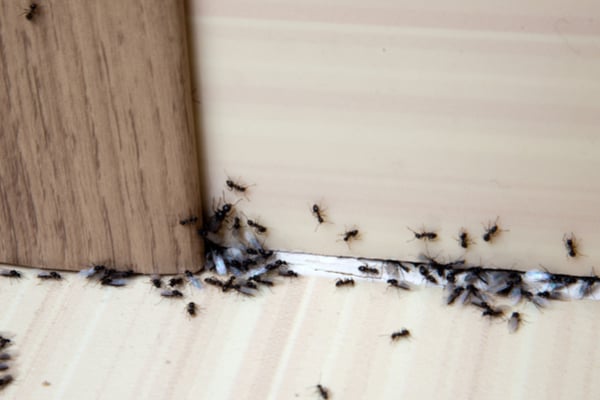The United States is home to over 3,400 spider species. We have spiders of every shape, size, and color. We also have a lot of them. Spiders live anywhere and everywhere, especially where people live.
Spiders are extremely common home infestors. In most cases, they aren’t harmful. In fact, they usually help dispose of other pests. That being said, you probably still don’t want to run into them. We can help make sure you don’t have to. Here are 8 (get it?) easy ways you can keep spiders away from your home.
Trim back shrubs and bushes
Spiders often climb from nearby branches onto home walls or rooftops. They may also make their way into overgrowth around homes in order to hide and build webs. The more cover spiders have, the more comfortable they’ll feel sticking around.
Try to maintain a three-inch clearing around the perimeter of your home. Trim back any branches or shrubs that grow into your clearing. Make especially sure that you trim away branches that brush up against or hang over your home. Keeping up with your lawn maintenance will keep other pests away from your home, too.
Clear clutter
Spiders thrive in cluttered, messy environments. They like the cover, hiding places, and web-building environments it provides. Cluttered basements and yards also provide the perfect hunting ground for spiders. They build their webs around various clutter to catch other pests making their way from cover to cover.
Clear away clutter outside and inside your home. Outside, pick up fallen branches, sticks, berries, and other debris. Mow your lawn short so you can see when stuff starts piling up. Inside, organize your basement and attic as thoroughly as possible. Keep boxes stacked and elevated.
Seal doors and windows
Gaps around doors and windows are the most common access points for all pests--not just spiders. In fact, spiders often build webs around doors and windows precisely because other pests make their way inside there.
Feel for drafts around each of your doors and windows. Patch up gaps or cracks with caulk. Replace worn-down weatherstripping. Make sure the doors and windows fit correctly in their frame. Consider replacing frames if they’re damaged, worn, or broken. Sealing up window frames goes a long way toward preventing pest infestations.

Prevent other pests
Spiders enter homes to build webs in warm places and hunt prey. Unfortunately, you probably can’t completely wipe out their food sources. The tiny arthropods spiders feed on live everywhere. You can make it more difficult for spiders to feed in your home than elsewhere, however.
Patch up windows and doors. Look for cracks around utility lines and baseboard. Install door sweeps and weatherproofing. Clean up food and water sources, especially in your basement and attic. De-clutter. Preventing pest infestations prevents spider infestations, too.
Remove webs
Building webs is hard work, so spiders like them to last as long as they can. If you can keep removing webs as soon as spiders make them, they’ll probably get the message.
Look for spider webs around windows, doors, utility lines, dark corners, and awnings. Vacuum them up with a hand vacuum as you find them. Throw out the bag in your outdoor dumpster when you’re finished. Check back on areas where you found spider webs frequently, and keep removing the webs as they return.
Use sticky traps
Sticky traps are glue strips meant to capture spiders and other pests alive. Place them in areas where you think pests move around regularly. Depending on what the traps capture, you’ll know what your pest problem is.
Place sticky traps in tight, secluded areas, especially around heat-producing appliances and fixtures. Try laying out sticky traps around your furnace, heater, vents, windows, HVAC units, and lighting fixtures. The more you use, the better an idea you can get about where the pests in your home are.
Replace your porch lights
White incandescent bulbs attract all kinds of insects. Moths, flies, beetles, and more all fly toward and around lights. CFL and halogen bulbs are slightly better than incandescent bulbs, but they attract bugs, too.
The best lights for keeping bugs away are yellow LEDs. Insects are less attracted to LED light than any other form of electric lighting. Just by replacing your outdoor light bulbs, you’ll go a long way toward keeping bugs away. By keeping bugs away, you’ll go a long way toward keeping spiders away.
Patch drafts
Drafts happen because of a small gap that lets cold air into your home. Small gaps can also let pests like spiders into your home. Look for and patch up drafts in your home. Start in your basement and work your way up. When you find a draft, patch it with caulk. Even tiny gaps can let insects inside, so be thorough.
Need some help dealing with a spider problem? Just give Plunkett’s Pest Control a call anytime. When it comes to controlling spiders--or any other pest, for that matter--we’re the right service for you. Keeping spiders away might be hard, but it’s not impossible… especially with professional help.






